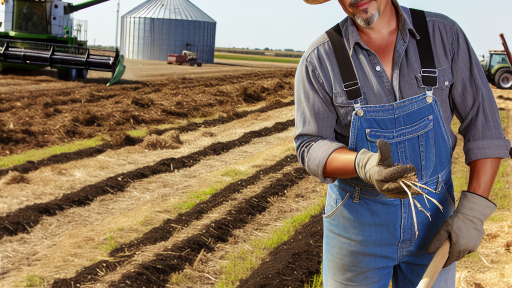Understanding Soil Composition and Structure
Components of Soil
S oil is composed of various components including minerals, organic matter, water, and air.
The mineral content includes sand, silt, and clay particles.
Each particle size plays a crucial role in soil behavior and health.
Organic matter enriches the soil and supports a diverse ecosystem.
Both microorganisms and macroorganisms contribute to organic structure.
S oil Layers and Horizons
S oil consists of distinct layers known as horizons.
The topmost layer is the O horizon, rich in organic matter.
Below it, the A horizon contains a mix of organic and mineral materials.
The B horizon serves as a zone of accumulation for leached materials.
Finally, the C horizon contains weathered rock and minerals.
S oil Structure and Texture
S oil structure refers to the arrangement of soil particles.
Good structure enhances aeration, drainage, and root penetration.
S oil texture is determined by the proportion of sand, silt, and clay.
S oil texture affects water retention and nutrient availability.
Influence of pH on Soil Health
S oil pH is a critical factor affecting plant growth and nutrient uptake.
Transform Your Agribusiness
Unlock your farm's potential with expert advice tailored to your needs. Get actionable steps that drive real results.
Get StartedMost plants thrive in a slightly acidic to neutral pH range.
Testing soil pH helps determine necessary amendments for improvement.
Role of Soil Microorganisms
Microorganisms play a vital role in nutrient cycling within the soil.
Bacteria, fungi, and protozoa help decompose organic matter.
They also contribute to soil structure by forming aggregates.
Maintaining a healthy microbial population is essential for soil fertility.
Importance of Soil Microorganisms for Soil Health
Role of Microorganisms in Soil
Soi l microorganisms play a vital role in maintaining soil health.
They contribute to nutrient cycling and organic matter decomposition.
Moreover, these microorganisms help in soil structure formation.
Healthy soil contains diverse microbial communities.
This diversity enhances resilience against pests and diseases.
Types of Beneficial Microorganisms
Several groups of microorganisms improve soil quality.
Bacteria decompose organic matter, releasing nutrients for plants.
Fungi contribute to the formation of soil aggregates.
Arbuscular mycorrhizal fungi form symbiotic relationships with roots.
This relationship boosts plants’ nutrient and water absorption.
Enhancing Soil Microorganisms
Farmers can adopt practices to promote microbial health.
For instance, using cover crops enriches the soil with organic matter.
Additionally, minimizing tillage preserves microbial habitats.
Organic amendments, such as compost, support microbial growth.
Rotating crops also helps maintain a balanced microbial ecosystem.
Impact on Soil Fertility
Healthy soil microorganisms directly impact soil fertility.
They increase the availability of essential nutrients to plants.
This availability enhances crop yields and quality.
Showcase Your Farming Business
Publish your professional farming services profile on our blog for a one-time fee of $200 and reach a dedicated audience of farmers and agribusiness owners.
Publish Your ProfileFurthermore, microorganisms improve soil’s water-holding capacity.
Microorganisms and Environmental Health
The presence of beneficial microorganisms promotes environmental health.
They help reduce dependency on chemical fertilizers and pesticides.
This reduction minimizes environmental contamination and pollution.
Moreover, healthy soils with active microorganisms sequester carbon.
This action contributes to climate change mitigation efforts.
Implementing Crop Rotation to Enhance Soil Nutrients
Introduction to Crop Rotation
Crop rotation is an effective agricultural practice.
It involves alternating different crops on the same land.
This technique significantly improves soil health.
Benefits of Crop Rotation
Crop rotation helps in managing soil fertility.
Each crop contributes unique nutrients to the soil.
Furthermore, rotating crops can break cycles of pests and diseases.
This leads to healthier plants and higher yields.
Types of Crop Rotation
There are various approaches to crop rotation.
For instance, one can use a simple two-crop rotation.
Another method involves a more complex multi-crop rotation.
These methods can be adapted based on specific soil needs.
Two-Crop Rotation
This method alternates two types of crops.
Legumes are often paired with non-leguminous plants.
This partnership helps restore nitrogen in the soil.
Multi-Crop Rotation
Multi-crop rotation includes three or more crops.
This diverse approach enhances soil structure and fertility.
Additionally, it provides better pest and weed control.
Best Practices for Effective Crop Rotation
Identifying crops that benefit the soil is crucial.
For example, deep-rooted crops improve soil structure.
Alternatively, shallow-rooted crops can increase surface nutrients.
Additionally, rotating crops based on seasons optimizes growth.
Spring and fall planting can lead to improved yield outcomes.
Challenges of Implementing Crop Rotation
Farmers may face challenges in changing their practices.
However, understanding the long-term benefits is essential.
Education and resources can help ease the transition.
Impacts of Crop Rotation on Sustainability
In adopting crop rotation, farmers promote sustainable practices.
This method enhances nutrient cycling and reduces chemical inputs.
Overall, crop rotation contributes to the long-term viability of agriculture.
Uncover the Details: Practical Mulching Tips for Effective Crop Management
Utilizing Cover Crops to Prevent Soil Erosion
The Importance of Cover Crops
Cover crops play a crucial role in soil preservation.
They protect the soil from erosion caused by wind and water.
Additionally, cover crops improve soil structure and fertility.
Types of Cover Crops
Various types of cover crops exist for different soil conditions.
Legumes, such as clover and vetch, enrich soil nutrients.
Showcase Your Farming Business
Publish your professional farming services profile on our blog for a one-time fee of $200 and reach a dedicated audience of farmers and agribusiness owners.
Publish Your ProfileBrassicas, like radishes, enhance soil aeration and drainage.
Grasses, including rye and oats, provide excellent ground cover.
How Cover Crops Prevent Soil Erosion
Cover crops establish a protective layer over the soil.
This layer reduces the impact of rainfall on bare soil.
Furthermore, root systems hold soil in place during heavy rains.
They also slow down water runoff, allowing for better absorption.
Implementing Cover Crops in Your Farming Practices
Integrate cover crops during fallow periods or after harvest.
Plant them early enough to establish growth before winter.
Choose varieties suited to your local climate and soil type.
Practice crop rotation to maximize the benefits of cover crops.
Monitoring and Maintaining Cover Crops
Monitor the growth and health of your cover crops regularly.
Manage pests and diseases to ensure optimal growth conditions.
Incorporate cover crops into the soil before planting cash crops.
Use appropriate tillage methods to preserve soil health.
Gain More Insights: Role Of Weather Data In Pest And Disease Forecasting
Incorporating Organic Matter Through Composting
The Importance of Composting
Composting enriches soil by adding essential nutrients.
It also improves soil structure and moisture retention.
Furthermore, composting helps reduce waste in landfills.
By recycling organic matter, we support sustainable practices.
How to Start Composting
Begin by selecting a suitable compost bin or pile location.
Ensure that the area is well-drained and easily accessible.
Next, collect kitchen scraps and yard waste for composting.
Include a mix of greens and browns for optimal results.
Greens provide nitrogen, while browns supply carbon.
Maintaining Your Compost
Turn your compost regularly to aerate it.
This process enhances decomposition and reduces odors.
Monitor moisture levels to keep your compost damp but not soggy.
Check for signs of completion, such as a dark, crumbly texture.
Using Finished Compost
Once your compost is ready, incorporate it into your garden beds.
Spread a layer of compost to enrich the topsoil.
Mix it well to ensure even distribution of nutrients.
Using compost increases soil fertility and plant health.
See Related Content: Data Driven Decisions For Optimal Crop Cultivation

Managing pH Levels for Optimal Nutrient Availability
Understanding Soil pH
Soil pH measures the acidity or alkalinity of your soil.
This level affects nutrient availability for plants.
Most crops prefer a slightly acidic to neutral pH of 6 to 7.
Extreme pH levels can hinder growth and yield.
Testing Soil pH
Regular testing is essential to monitor soil pH.
You can use home testing kits or professional services.
Test at different locations within your field for accuracy.
Showcase Your Farming Business
Publish your professional farming services profile on our blog for a one-time fee of $200 and reach a dedicated audience of farmers and agribusiness owners.
Publish Your ProfileAdditionally, consider testing at various seasons.
Adjusting Soil pH
There are several methods to adjust soil pH levels.
To raise pH, consider adding lime or wood ashes.
To lower pH, incorporate sulfur or organic matter.
Make adjustments gradually to avoid shocking your soil.
Maintaining Optimal pH
Maintain optimal pH through regular monitoring and amendments.
Incorporate crop rotation and cover crops to improve soil health.
Furthermore, avoid excessive fertilizer applications.
Balanced fertilization enhances nutrient uptake by plants.
Integrating pH Management into Soil Health Practices
Integrate pH management with other soil health practices.
Focus on organic amendments to promote soil life.
Additionally, consider utilizing mulching to protect soil structure.
These practices collectively improve nutrient flow and availability.
Delve into the Subject: Integrating Livestock in Organic Crop Management
Reducing Soil Compaction with Conservation Tillage
Understanding Soil Compaction
Soițl compaction occurs when soil particles are pressed together.
This process reduces pore space and restricts root growth.
As a result, water infiltration and aeration are hindered.
What is Conservation Tillage?
Conservation tillage is a farming practice that preserves soil structure.
This method minimizes soil disturbance compared to traditional tillage.
Farmers use techniques that leave at least 30% of the soil covered.
Benefits of Conservation Tillage
This approach significantly improves soil health.
First, it reduces soil erosion by protecting the surface.
Second, it enhances organic matter retention.
Additionally, soil moisture levels increase due to reduced evaporation.
Implementing Conservation Tillage
To adopt conservation tillage, farmers should follow key practices.
Assess current soil health and compaction levels before starting.
Use direct seeding or strip-tillage methods for planting.
Integrate cover crops to stabilize soil and enhance nutrients.
Choosing the Right Equipment
Farmers should select equipment that complements conservation practices.
For example, no-till drills and strip-tillage tools are effective.
Proper machinery helps maintain soil structure while planting.
Monitoring and Adjusting Practices
Continuous monitoring is essential for successful implementation.
Farmers should regularly evaluate soil compaction and health.
Adjustments may be necessary based on crop performance and soil tests.
Implementing Quality Water Management Practices
Establishing Goals for Water Management
Start by defining clear water management objectives.
These goals should align with your overall soil health strategy.
Having well-defined aims simplifies evaluation and adjustments.
Identifying Water Sources
Assess available water sources on your property.
Consider both surface and groundwater resources.
Document their capacity and quality for efficient planning.
Showcase Your Farming Business
Publish your professional farming services profile on our blog for a one-time fee of $200 and reach a dedicated audience of farmers and agribusiness owners.
Publish Your ProfileCreating a Water Management Plan
Develop a comprehensive plan addressing water usage.
This plan should include timing, quantity, and method of application.
Utilize technology for monitoring and management efficiencies.
Implementing Efficient Irrigation Systems
Choose the right irrigation system for your needs.
Drip irrigation often provides better efficiency than traditional methods.
Test these systems regularly to prevent water loss.
Monitoring and Analyzing Water Quality
Regularly test water quality to ensure safety for crops.
Use laboratory services to assess contaminants accurately.
Adjust your practices based on the results of these tests.
Adopting Rainwater Harvesting
Implement rainwater harvesting systems to supplement irrigation.
These systems collect and store rainwater for future use.
This practice reduces reliance on groundwater sources.
Training and Engaging Stakeholders
Involve all relevant parties in water management efforts.
Provide training to ensure everyone understands best practices.
Engagement fosters a collaborative approach to water conservation.




